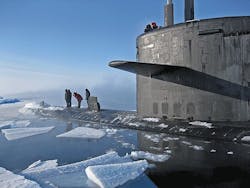DARPA approaches industry for unmanned sensors to monitor Arctic land, sea, and air traffic
Officials of the U.S. Defense Advanced Research Projects Agency (DARPA) in Arlington, Va., released a solicitation Tuesday (DARPA-BAA-15-28) for the Future Arctic Sensing Technologies project, which seeks to capitalize on commercially developed technologies to monitor the Arctic region for military activity.
For this project DARPA remote sensing experts are asking for proposals for low-cost unmanned air, surface, and subsurface sensing systems for the Arctic, including ways to deliver sensor information to remote sites.
The Arctic increasingly sees military and commercial activity, yet U.S. capabilities to monitor these activities are limited, DARPA researchers say. The Arctic has little fixed infrastructure to support sustained operations, and remote-sensing systems must be rugged and durable enough to operate in the harsh Arctic cold.
Today's unmanned systems are developing the range and environmental performance for the Arctic, researchers point out, and commercial electronics can provide low-cost and energy-efficient sensing systems capable of low temperature operation.
Satellite communications (SATCOM) technologies like Iridium and Argos enable data relay from remote Arctic systems to manned analysis and observing centers, researchers say.
DARPA wants to capitalize on these kinds of technologies for Arctic sensor systems. Proposed solutions should be rapidly deployable above the Arctic Circle, environmentally benign, and capable of unrefueled operation in the Arctic environment for at least 30 days.
Systems should sense, identify, and report data on aircraft, surface vehicles, people traveling on foot, surface ships, and submarines that may have significance for military surveillance.
DARPA has about $4 million to spend on this project, and several contract awards are possible. Companies interested should respond to the DARPA Website at https://baa.darpa.mil no later than 14 April 2015.
Email questions or concerns to DARPA at [email protected]. More information is online at https://www.fbo.gov/spg/ODA/DARPA/CMO/DARPA-BAA-15-28/listing.html.

